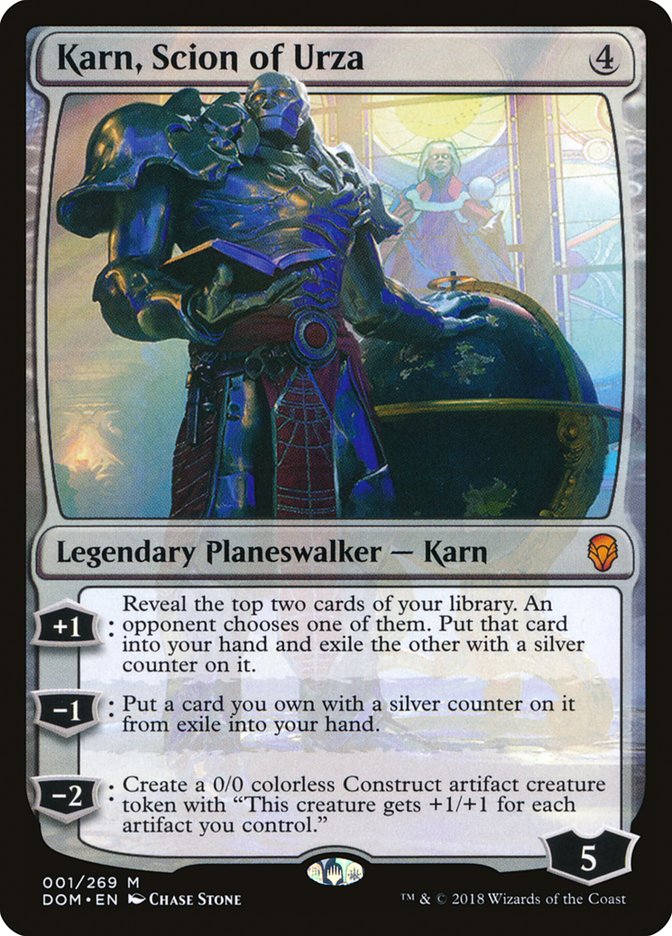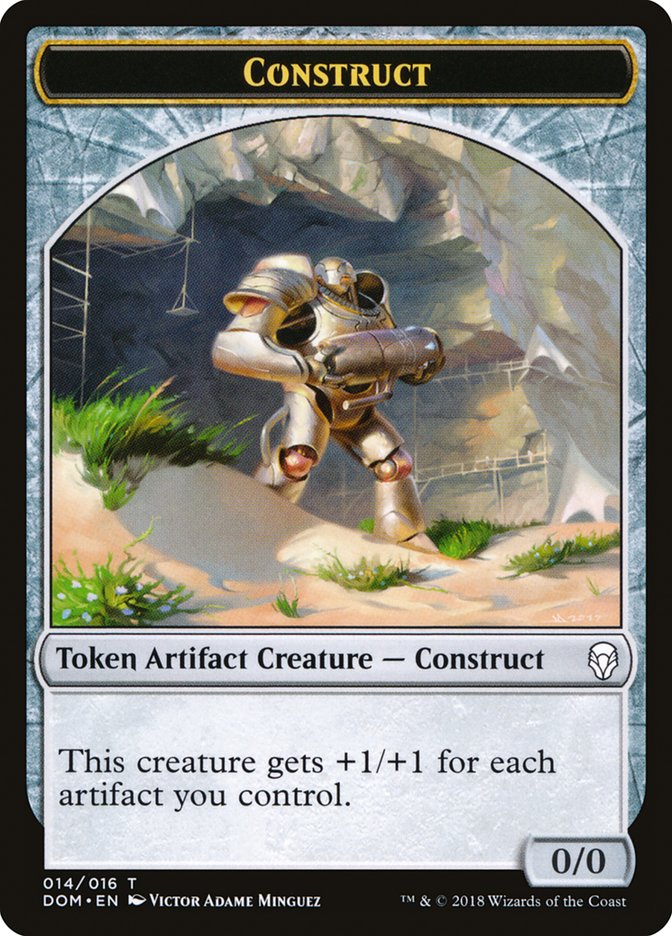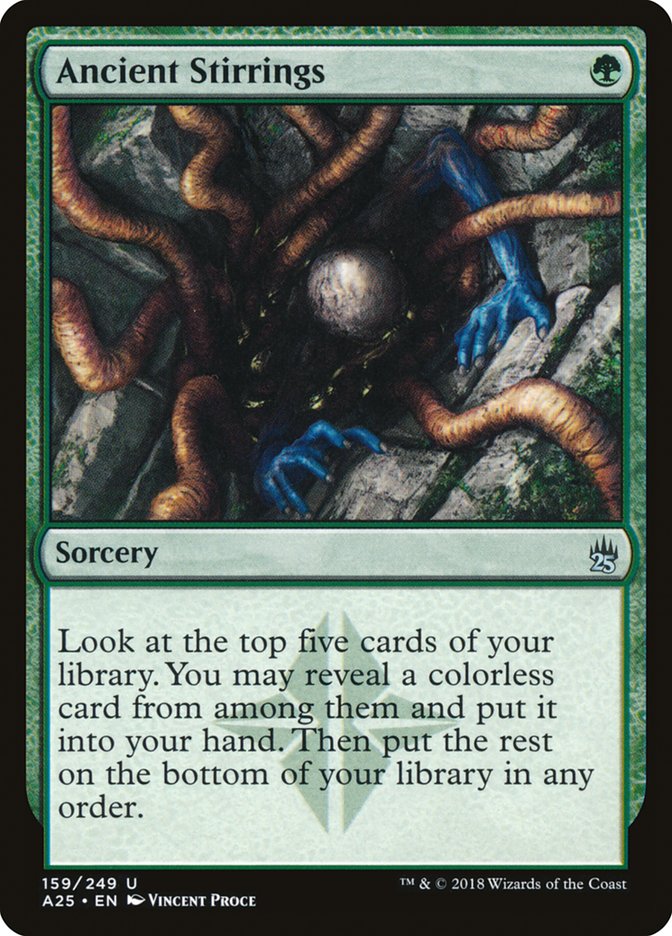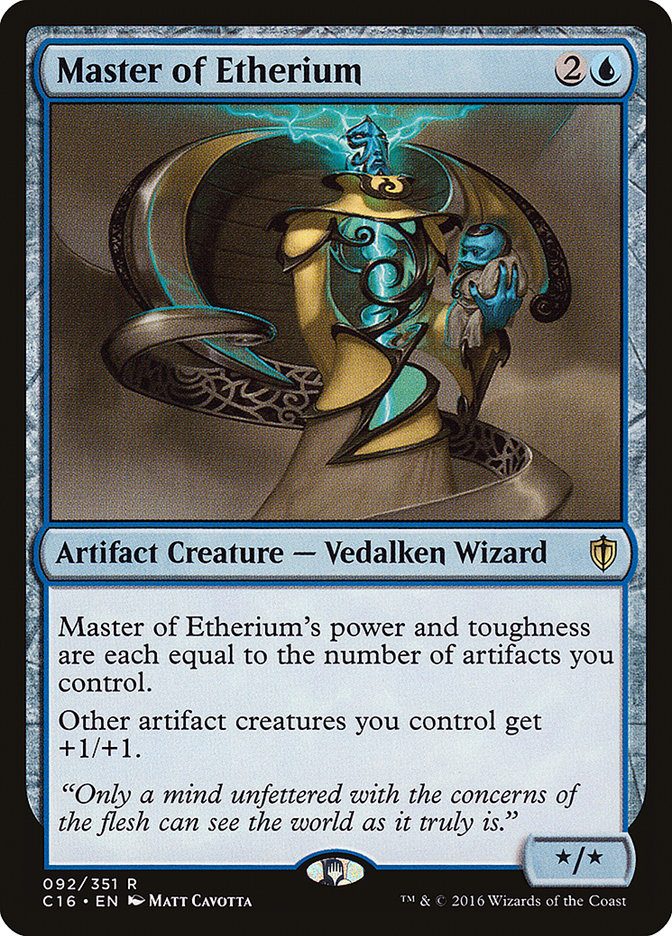Since Modern’s inception, Affinity has been effectively the same deck, focused around Cranial Plating, Arcbound Ravager, and Master of Etherium and/or Etched Champion in combination with fast mana from Springleaf Drum and Mox Opal. Trying to abuse Mox Opal and Cranial Plating has homogenized the deck into the following:
Creatures (21)
Lands (16)
Spells (12)

…plus three three-dop threats and a single basic land.
This core is basically untouchable and therefore leaves little room for innovation within the archetype. This has led to a stagnant Affinity that has not developed and adapted nearly as well as the rest of Modern.
But that all has changed after a small conversation with Caleb Scherer. At SCG Atlanta, he pulled me aside and asked if I had thought about playing Ancient Stirrings in Affinity in place of Thoughtcast or Galvanic Blast. I told him I hadn’t but that the idea was intriguing and I would try it out.
While I was not brave enough to pull the trigger for SCG Baltimore earlier this year, I kept coming back to the idea of Ancient Stirrings. I hammered out a list, ran through a few Magic Online leagues and was having incredible success. When SCG Regionals came around, Austin Collins called and told me he needed some help in Modern. I shipped him this list and a sideboarding guide:
Creatures (24)
- 4 Arcbound Ravager
- 4 Ornithopter
- 3 Steel Overseer
- 2 Memnite
- 3 Etched Champion
- 4 Signal Pest
- 4 Vault Skirge
Planeswalkers (2)
Lands (17)
Spells (17)
Sideboard

After gathering data from both of our Regionals and from another dozen or so Leagues on Magic Online, I came up with the list that led Austin to his second SCG Tour Invitational Top 8 and gave me a solid 6-2 finish in Modern on my way to the Top 32.
Creatures (24)
- 4 Arcbound Ravager
- 4 Ornithopter
- 3 Steel Overseer
- 2 Memnite
- 3 Etched Champion
- 4 Signal Pest
- 4 Vault Skirge
Planeswalkers (2)
Lands (17)
Spells (17)

Why Karn, Scion of Urza?
Karn, Scion of Urza, while not as overtly powerful as Karn Liberated, offers Affinity something it has lacked: card advantage. The typical play pattern with Karn is to -2 when you play it and then immediately -2 the next turn. This creates two Constructs that are functionally Master of Etherium without the Anthem effect; their large size and ability to scale with the game make them hard to deal with in combat and they provide a blisteringly fast clock.
After making two large bodies, Karn acts as a card advantage engine, fueling your critical mass of artifacts by giving you more artifacts and/or lands and constantly threatening to get you cards like Cranial Plating and Arcbound Ravager with its -1. Other than nearly impossible Turn 2 kills, I quickly identified that casting a Turn 2 Karn was the most powerful thing I could be doing in Affinity.
On Turn 2, Karn is the highest-impact and most resilient threat that Affinity can produce. Unfair decks can take a hit or three from a creature with Cranial Plating while developing their own gameplay and fair decks can simply trade with every creature the Plating equips.
While these plans are certainly exploitable from the Affinity side, a Turn 2 Karn lets you play the game on easy mode. Usually the Turn 4 attack with two Construct tokens is lethal by itself, discounting the other creatures and payoff you draw, and this forces your combo opponent to interact or to go for the combo without having enough time to set up.
Against fair decks with Lightning bolt, you can immediately minus Karn to make a large beater, and if they want to trade their Bolt for half of your Karn, you’re still up on value. If your hand hinges on Karn as your only payoff, you can immediately plus Karn for a card and then minus the next turn to protect him.
Karn is so resilient in Affinity because it’s extremely difficult to pressure him effectively. The Construct is usually at least a 5/5 or 6/6, bigger than a traditional Tarmogoyf, and even if your opponent kills the Construct, you can simply chump block with a mostly disposable Ornithopter or Memnite. This allows Karn to continue to churn through cards and keep making tokens well into the mid-game.
Because Karn is so expensive, you can only afford to play two copies in the maindeck, but my desire to jam Turn 2 Karns drew me back to the conversation with Caleb Scherer.
Why Ancient Stirrings?
Ancient Stirrings is one of the most broken cards in Modern. For years, it has enabled degenerate combo decks like Tron and Amulet Titan, and now it’s breaking Affinity.
Since I was operating under the assumption that Turn 2 Karn was the most powerful thing you could be doing in Affinity, I wanted to maximize the number of Turn 2 Karns without making Affinity too clunky by running so many four-drops. Ancient Stirrings fit this role perfectly. To cast a Turn 2 Karn, you need two pieces of fast mana, two lands, a zero-drop creature to enable Springleaf Drum or Mox Opal, and the Karn itself.
Ancient Stirrings allows you to find the missing piece of puzzle, whether that’s Mox Opal, the Karn, or even your second land. The power of card selection has caused cantrips like Ponder and Preordain to be banned due to their ubiquity in any blue deck. Ancient Stirrings is a more powerful effect with the “drawback” of playing almost all colorless cards.
Against unfair decks like Storm or Ironworks, your best route to victory is usually to try to make a five-power Inkmoth Nexus with Arcbound Ravager or Cranial Plating and put them on a two-turn clock. This can force your opponent to try to go off before they’re fully set up and allow you to steal a win where your normal damage route is going to be too slow. However, setting up this two-card combo wasn’t easy in a deck with zero card selection. Now, with Ancient Stirrings, you can set up the Inkmoth Nexus kill against unfair decks regularly.
Against fair decks, Ancient Stirrings gives you an additional way to dig for your high-impact threats such as Etched Champion and Karn, Scion of Urza. Karn and Etched Champion allow you to beat hands full of removal spells and dodge most of the best hate against you, such as Kolaghan’s Command and Electrolyze.
Ancient Stirrings gives you both consistency and redundancy against traditionally bad matchups such as Jund and Mardu Pyromancer. I firmly believe that addition of stirrings gives you a 50-50 matchup against Mardu Game 1 because they have an extremely difficult time beating an Etched Champion if you can resolve it through their discard spells, and Stirrings gives you a greater chance of “topdecking” Etched Champion.
Why Not Master of Etherium?
Just a few weeks ago, I made the Top 8 of SCG Atlanta with three copies of Master of Etherium in the maindeck and a fourth in the sideboard. Two weeks ago, Frank Karsten, one of the best Affinity players in the world, posted his updated list with four copies of Master of Etherium in his maindeck. And while I respect and admire Frank’s dedication to Affinity and his immense knowledge of the deck, I think that playing Master of Etherium in the maindeck is a fatal mistake.
Master of Etherium is theoretically more consistent than Etched Champion, as it’s always a big beater that pumps your team, rather than a textless 2/2 against colorless decks. The problem is that it doesn’t actually play out that way in metagame full of Jeskai Control, Mardu Pyromancer, and Humans. Too often Master of Etherium falls victim to your opponent’s one-for-one plan out of the control or midrange decks and is bounced or chump blocked by Humans. Without Etched Champion, you significantly reduce your Game 1 percentages against fair decks and Humans, and in this metagame, you can’t afford it.
Master being a huge nonbo with Ancient Stirrings also pushes me away from the card, as I want all my high-impact threats to be Ancient Stirrings hits.
Sideboarding
Post-sideboard games are always scary when playing Affinity because everyone loves to pack some kind of hate like Ancient Grudge, Stony Silence, or Kataki, War’s Wage that can singlehandedly win them the game. However, Affinity, as an ironically five-color deck, has access to some of the best and highest-impact sideboard cards in Modern (aside from Stony Silence, unless you really want to beat the mirror).
But you must be careful: if you cut too many of your artifacts, your synergy deck begins to fall apart. Because of this, I rarely sideboard in more than six or seven cards and never cut cards like Memnite. You need zero-mana artifacts to enable all of your busted draws, and trying to get under fair decks with a fast start is one of the best ways to steal sideboard games.
Mono-Green Tron
Out:
In:
After sideboarding, Tron gets access to some additional removal, but you get access to relevant and meaningful disruption while getting to trim your slow and dead cards. I would make sure to mulligan any hand without disruption and a reasonable clock unless you have a Turn 3 or 4 kill.
Jeskai Control
Out:
In:
Nothing super-groundbreaking in this matchup. You don’t want cards that require you to commit heavily to the battlefield in the face of Supreme Verdict and you want ways to push through your threats.
The key to this matchup is to try to set up a turn where you can force them to use their mana, either by making them tap your team with Cryptic Command or countering a threat, and then slam an Etched Champion or Ghirapur Aether Grid. Do not be afraid to keep hands with three lands in this matchup, especially if they are creature-lands, as an early mana advantage is key to creating those double-spell turns.
Humans
Out:
In:
Signal Pest is bad in the matchup because it can’t attack through Kitesail Freebooter and Mantis Rider and, after sideboarding, is a major target for Izzet Staticaster. Karn stays in because Humans cuts Thalia, Guardian of Thraben against you and it creates blockers that can hold back large copies of Champion of the Parish.
On the play, I usually try to hold up a removal spell on my second turn to play around Kataki, War’s Wage, even if it sets you behind. Save your removal spells for threats like Meddling Mage, Kataki, or Mantis Rider. Don’t waste it on mana accelerants or early copies of Champion of the Parish.
Out:
In:
This matchup is extremely unintuitive after sideboarding. Game 1 is a race in which you are heavily favored because of their lack of flyers and low density of removal. However, after sideboarding, Hollow One morphs into a B/R Control deck splashing Ancient Grudge.
This makes cards like Etched Champion and Karn, which you would traditionally sideboard out against Hollow One’s maindeck, into extremely important and relevant threats. If you can halt their recursive threats like Bloodghast with Rest in Peace or Dispatch, you can buy yourself enough time to overcome their removal. Play this matchup like you would against Jund and you’ll reap the rewards.
Affinity
Out:
In:
I could write an entire article about the Affinity mirror because it’s so complex and has so many layers to it. Ghirapur Aether Grid is far and away the best card in the mirror and I would mulligan any medium seven-card hand in the matchup to dig for it. I’m a huge fan of aggressively using my removal spells and artifact destruction spells to cut any amount of mana my opponent has access to when on the play. I think you should be blowing up Mox Opal way more often than you probably do, especially when you get to Flashback Grudge on their follow-up threat.
Storm, on the Draw
Out:
In:
Storm, on the Play:
Out:
In:
On the draw, Steel Overseer is simply too slow to be relevant. On the play, you force them to choose between killing your Overseer or sculpting their hand or deploying a mana creature. Always be careful of them using Grapeshot as a giant removal spell, so conserve your Arcbound Ravagers until you absolutely must commit one. Hope they don’t draw Shattering Spree (or Thoughtseize it away).
G/W Hexproof
Out:
In:
This is one of the few matchups Karn is actively bad in. The Construct tokens are not big enough to block, nor can they attack through a creature with Daybreak Coronet. I aggressively take Spider Umbra with Thoughtseize, since you mostly win with flyers. After sideboarding, I like aggressively going all-in on Inkmoth Nexus because Stony Silence will wreck you if you wait too long. This isn’t a great matchup, but if you can read your opponent well, you can pull ahead.
Burn
Out:
In:
This is a terrible matchup after sideboarding. Burn turns into a R/W Control deck with a fast clock and ways to destroy all your payoffs. I would mulligan aggressively for fast, resilient hands that can cast a Turn 2 Etched Champion. I bring in the Ancient Grudge as a hedge against Ensnaring Bridge, so if you see that your opponent has foolishly kept Eidolon in, I would switch it for the Wear // Tear.
If there’s a lot of Burn in your metagame, I would consider playing a second Spell Pierce over the second Thoughtseize in your sideboard and cutting another Steel Overseer.
Jund
Out:
In:
I’m a huge fan of Rest in Peace in this matchup because it’s a removal spell for Tarmogoyf and Scavenging Ooze that stops the Flashback on Ancient Grudge. I tend to keep even mediocre seven-card hands against Jund because mulliganing against their discard spells and plethora of answers is a losing strategy. If you can, kill whatever creature they cast on Turn 2, as the easiest way to lose this matchup is for them to get to play like a Delver of Secrets deck, sticking any threat and then simply beating you down while using their disruption.
Mardu Pyromancer
Out:
In:
This matchup is rough. Etched Champion is your saving grace and you should try to sculpt your gameplan around abusing it. Ghirapur Aether Grid allows you to steal games against their heavy Lingering Souls draws and can really punish them if they are leaning on a few tokens to block. I wouldn’t keep hands that hinge on Cranial Plating because they have so many ways to kill it and to block the creature it powers up.
Taking their threats with Thoughtseize is generally a better strategy than taking answers, simply because they have so few threats, but I would take Wear // Tear in order to protect a Ghirapur Aether Grid.
General Thoughts
I have only begun to explore Ancient Stirrings’s potential in Affinity. I believe that powerful colorless sideboard cards like Pyrite Spellbomb or Relic of Progenitus could be used over Galvanic Blast or Rest in Peace. In addition, I think it’s worth exploring different shells of Affinity, maximizing the combo between Arcbound Ravager and Walking Ballista / Hangarback Walker.
May you draw exactly one Mox Opal.






